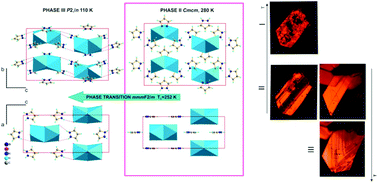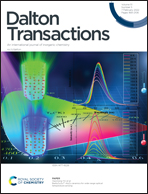(C3N2H5)3Sb2I9 and (C3N2H5)3Bi2I9: ferroelastic lead-free hybrid perovskite-like materials as potential semiconducting absorbers†
Abstract
We have synthesised and characterised novel organic–inorganic hybrid crystals: (C3N2H5)3Sb2I9 and (C3N2H5)3Bi2I9 (PSI and PBI). The thermal DSC and TG analyses indicate four structural phase transitions (PTs) at 366.2/366.8, 274.6/275.4, 233.3/233.3 and 142.8/143.1 K (on cooling/heating) for PSI and two reversible PTs at 365.2/370.8 and 252.6/257.9 K for PBI. Both analogues crystallize at room temperature in the orthorhombic Cmcm structure, which transforms, in the case of PBI, to monoclinic P21/n at low temperature. According to the X-ray diffraction results, the anionic component is discrete and built of face-sharing bioctahedra, [M2I9]3−, in both compounds, whereas cations exhibit distinct dynamical disorder over high temperature phases. Dielectric spectroscopy and 1H NMR spectroscopy have been used to characterise the dynamical state of the C3N2H5+ cations. The ferroelastic domain structure has been characterised by observations under a polarized optical microscope. Both compounds are semiconductors with narrow bandgaps of 1.97 eV (PBI) and 2.10 eV (PSI).



 Please wait while we load your content...
Please wait while we load your content...